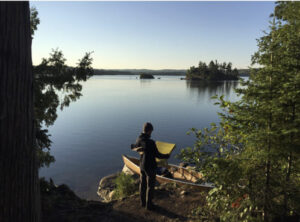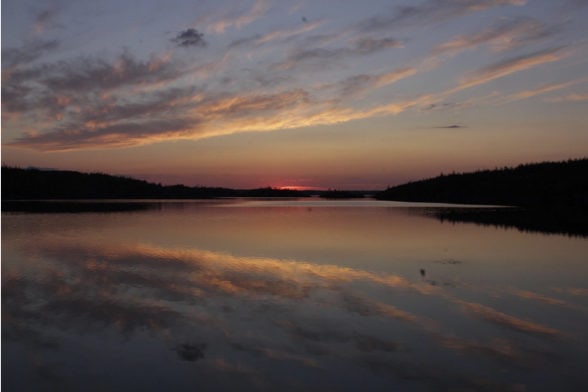[Above: Canoeing into the Boundary Waters. All photos by Thomas Winderl]
America’s Most Popular Wilderness Threatened
It seems hard to believe that the largest wilderness area in the United States is just a car ride away from my home in Minneapolis, Minnesota, but the Boundary Waters Canoe Area Wilderness (BWCAW) is just that—a 6-hour drive into northern Minnesota up near the Canadian border. You’ll see signs of city life slipping away. First, the turn-off in Grand Marais, heading towards the Gunflint trail on a 2-lane highway through the northern pines of the Superior National Forest. Cell service begins to fade in and out with the rise and fall of the rolling hills. Sparkling blue water flashes through the trees. Trailheads become more and more frequent. Finally my friends and I arrive at the outfitter to pick up the canoes. No more than 15 minutes later we are back in the car following the outfitter to our designated launch point with the overnight camping permit we had picked up earlier that day at the Ranger Station in Grand Marais. There are three of us, ready to spend four nights escaping to the wilderness, canoes our transportation and everything we need tucked in our backpacks.
The ability to visit a place like this is not guaranteed. The BWCAW ecosystem is resource-rich. Valuable copper and nickel mineral deposits are suspected to lie below the protected lands and adjacent National Forest areas. The Boundary Waters is a federally protected Wilderness Area, but nothing is guaranteed in today’s world. In 2015, Minnesota Governor Mark Dayton signed legislation that banned sulfide-ore mining. In September 2018, the Trump administration lifted a ban on mineral exploration in lands right next to the BWCAW. The pristine beauty that is found in the Boundary Waters and the ecosystems it holds are currently under threat of being destroyed by the copper mining industry after the White House’s Secretary of the Interior cancelled a decision to put a 20 year pause on any mining exploration while an Environmental Impact Study was conducted.
What’s at Stake
I marvel at those who are living in the past, refusing to understand the value in protecting the diverse ecosystem that we are now beginning to explore. The expansive landscape is covered by hundreds of lakes, all located in close proximity to one another. Portaging between them is a common part of any BWCAW adventure. In the early part of the day, we see a few other canoes on the water, a kayak here and there, and that is all—despite it being Labor Day weekend. As we weave through the maze of small islands left by glaciers cutting through the region, loons call out to one another, breaking the silence with that distinct sound any true Minnesotan can quickly identify.
It doesn’t get more pristine than the untouched ecosystems found throughout the wilderness area. Under the Leave No Trace policy, visitors are respectful of the earth and pack out everything they pack in, including all garbage. That ensures that visitors have as little impact as possible on wildlife that lives here: black bears, moose, wolves, deer, and many others. The trees are alive with large predatory birds such as bald eagles and hawks, which can count on a fresh supply of fish in the lakes below. The lakes are full of trout, walleye, northern pike, bass, and perch—a fisherman’s heaven.
We look for our island campsite by navigating through the islands using our map. The campsites aren’t marked, blending into the shoreline. We can identify them only by getting out of the canoe to confirm the site has a fire grate. All sites have a fire grate and a toilet. Camping is not permitted at nondesignated sites, another effort to limit the human impact on the natural environment and leave it untouched for future visitors to enjoy.

We find our site and pitch camp for the night. I boil water to make dinner while the other two go off to collect firewood. Only dead wood is allowed to be burned in the Boundary Waters, and there are plenty of fallen sticks and trees around that make a perfect fire for the evening. As the water comes to a boil and I prepare the light-weight dehydrated meals we had brought along, the beauty of the sunset catches me off guard. I couldn’t help but watch as the sun slowly dropped, sliding in between the sea of islands in front of me. Vibrant oranges, yellows and reds filled the sky, all reflected in the glass surface of Seagull Lake.
It didn’t seem possible that just earlier that day we had been sitting in our car, driving through Duluth on the way north, but here we were alone in the wilderness with no other signs of human activity in sight. All three of us sat out on the southwest point of the island eating our dinner in silence, taking in the scenery and sounds of the natural world we are fortunate enough to be a part of.

The land around us is federally protected—for now. The threat from mining is very real, with a massive potential impact. The water systems in the Boundary Waters are so closely connected, with many directly connected by a series of streams, that contamination of one will have a ripple effect, spreading throughout the lakes.
Mining versus Tourism—and Public Will
A 2012 study found that 100% of the mines tested leaked contaminates, with 92% having lasting effects on the water quality in the surrounding areas. By lifting the ban on mining exploration, the Trump Administration threatens not only the natural beauty of the region, but also the $913 million in tourist revenue generated in Minnesota during 2017, a significant portion of it directly or indirectly attributed to tourism in the Boundary Waters Canoe Area.
The move by the Trump Administration breaks a commitment to Congress and the American people, who spoke out and voiced their vote to keep the BWCA Wilderness protected. Per the Save the Boundary Waters press release, it “completely disregards the voices of over 180,000 American citizens who participated in good faith in public comment periods held by the US Forest Service. During the first comment period for the study 98% of respondents urged protection of this wild and beautiful place.”
American people have been rallying through online campaigns, contacting state representatives, and funding public campaigns to gain attention to the issue through advocacy groups in local communities.
Those people are the face of this battle for the BWCAW. Government-protected land wasn’t always a concept found in countries across the globe. Others are in similar situations around the world, struggling to make their friends, neighbors, and community see the long-term need to reduce the human impact on the natural world.
To side with BWCAW protection, people can contact their state representatives today, voice their opinions, sign the petition at https://www.savetheboundarywaters.org/ and help protect one of America’s greatest national treasures.
I leave you with a personal appeal. Do you wish to look back on your life and realize that when you were are at the forefront of an environment war you took no action? Or do you want to think back on moments like this one—bobbing silently in your canoe, taking in the sunset on Seagull Lake, and knowing that because of people like you the Boundary Waters Canoe Area remains safe from harm?

